The massive growth of the global drug trade by land, sea and air has allowed traffickers to operate with impunity. Sea containers are the most profitable method of transporting cocaine, heroin and methamphetamine by sea.
India has become an attractive destination for drug traffickers looking for higher profits and lower risks. This is because market prices are higher, legal procedures are complex and favor traffickers and vendors, and legal penalties for possession and consumption are lighter than in most other countries. Additionally, India’s interdiction efforts at domestic and international borders are often hampered by jurisdictional and legal issues.
The massive growth of the global drug trade by land, sea and air has allowed traffickers to operate with impunity. Sea containers are the most profitable method of transporting cocaine, heroin and methamphetamine by sea. The Arabian Sea has become a hotspot for the illegal drug trade. Criminal networks are strategically located at the intersection of Africa, the Middle East and Asia, using this route to transport drugs and weapons.
On May 23, 2024, the Royal Navy destroyer HMS Diamond intercepted an unflagged fishing vessel transporting approximately 2,382 kilograms of cannabis while patrolling in the Arabian Sea. The seizure is the ninth narcotic drug interception in 2024 by the U.S.-led maritime coalition of 44 countries.
While the lack of actual shipping documents, weapons serial numbers and GPS tracking makes it difficult to determine the origin and destination of seized ships, maritime interceptions have revealed some patterns. Most trafficking vessels are stateless and operated by Yemeni and Pakistani crews.
On April 13, 2024, the Indian Navy frigate INS Talwar deployed in the Western Arabian Sea under the jurisdiction of Bahrain’s Combined Maritime Force (CMF) seized a suspected dhow and recovered 940 kilograms of drugs. The frigate is part of the Operation Crimson Barracuda focus, led by Combined Task Force (CTF) 150.
On March 13, 2024, the Narcotics Control Bureau (NCB) seized 62 kg of methamphetamine in the Arabian Sea during a joint operation with the Anti-Terrorism Squad (ATS) of Gujarat and the Coast Guard. In an earlier operation, NCB and Gujarat ATS made the largest ever seizure in the Arabian Sea. Operation Sagar Manthan-1 resulted in the seizure of 3,110 kg of cannabis, 158 kg of methamphetamine and 24 kg of heroin.
Drugs trafficked through the Arabian Sea and Bay of Bengal maritime routes account for nearly 70% of illegal drugs smuggled into India. Heroin is the most trafficked drug by sea, but drugs seized also include amphetamine-type stimulants (amphetamine-type stimulants), cannabis, cocaine and others. In one of the largest-ever drug seizures by an Indian agency, the Directorate of Revenue and Intelligence (DRI) seized 2,988 kilograms of Afghan heroin worth Rs 21,000 crore from Mundra port in September 2021.
The Afghanistan-Pakistan corridor is the main thoroughfare for the islands of the Western Indian Ocean, namely Mauritius, Seychelles, Madagascar, Comoros, and the French overseas territories of Mayotte and Reunion. The region is also closely associated with the illegal dynamics affecting the west coast of India.
The Eastern Indian Ocean region, including Bangladesh, the Maldives, India and Sri Lanka, faces the ongoing threat of illegal drug trafficking, threatening the region’s national security and socioeconomic development. It is also the world’s largest opium consumer market. In 2021, India reported its highest drug seizures on sea lanes in three decades.
In southern India, the Tamil Nadu-Sri Lanka coast has been identified as the outbound route for smuggling heroin from Afghanistan and Pakistan; the Tamil Nadu coast is a transit point for locally produced “brown sugar”, which is further transshipped to European and American markets. Ports such as Kochi, Kolkata, Mumbai and Chennai are used as transit ports for drug trafficking.
In 2019-21, joint operations by Indian agencies resulted in the capture of Pakistani vessels engaged in drug trafficking off the coast of Gujarat. In August 2020, the National Investigation Agency (NIA) also launched an investigation into the smuggling of heroin through sea routes based on drugs seized in Saraya (Gujarat). In November 2021, the Gujarat Anti-Terrorism Squad (ATS) conducted an investigation into heroin seized in the interior of Gujarat and found that there was a conspiracy to divert the drugs to India.
An NCB investigation in 2021 uncovered the modus operandi of the “Southeast Passage”, whereby drugs are transshipped at sea between Iranian and Pakistani fishing vessels and Sri Lankan and Maldivian fishing vessels. In November 2020, a Sri Lankan ship was seized south of Tuticorin carrying drugs, weapons and satellite phones, which also showed that the drugs were transshipped from a Pakistani dhow. The UNODC 2015 report entitled “Trafficking of Afghan Opiates through the Southern Route” is the authoritative reference on Pakistan’s role in facilitating the production, transport and sale of narcotics originating in Afghanistan and parts of Pakistan . Another EU-funded research paper published in 2018 titled “The Heroin Coast – The Political Economy of the East African Coast” identified Pakistan as a key player in establishing narcotics supply chains on Africa’s east coast.
The five coastal countries of South Asia, Bangladesh, India, the Maldives, Pakistan and Sri Lanka, are vulnerable to drug trafficking due to their criss-crossed and long-entrenched maritime trafficking routes. Forcing drug traffickers to leave the Arabian Sea cannot be accomplished overnight.
Author: Former Director of the National Institute of Customs, Indirect Taxes and Narcotics

